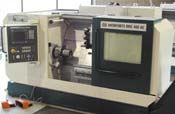Guide Column Replaces Linear Ways
These machines feature a hydrostatic way system allowing the main carriage slide to travel on a cylindrical guide column with no metal-to-metal contact, developers say. This hydrostatic design eliminates any stick-slip effect in axis travel and greatly reduces wear.
Share


.png;maxWidth=45)
DMG MORI - Cincinnati
Featured Content
View More
Takumi USA
Featured Content
View More





Hwacheon Machinery America, Inc.
Featured Content
View MoreDozens of machine tool builders around the world are selling CNC turning centers, and most of these companies have targeted the expansive U.S. market for these products. So what would induce an equipment manufacturer to enter this already crowded field? The company would have to have something rather different to set itself apart from the many competitors.
Apparently, American Monforts believes that the unique design of its CNC turning machines sets these lathes apart sufficiently to capture a share of the U.S. market. These machines feature a hydrostatic way system allowing the main carriage slide to travel on a cylindrical guide column with no metal-to-metal contact, developers say. This hydrostatic design eliminates any stick-slip effect in axis travel and greatly reduces wear.
American Monforts, whose U.S. headquarters are in Charlotte, North Carolina, is a subsidiary of A. Monforts GmbH & Co. in Germany. The parent firm has been building and selling lathes for almost 90 years, but mostly in its domestic market, where it has a reputation as a high-precision lathe builder. Monforts also produces an extensive line of fabric dyeing and finishing machines, which it has marketed quite successfully to the U.S. textile industry for 20 years from its base in Charlotte. This location is centrally located to most American textile factories.
With the way covers removed from a Monforts lathe, the longitudinal (Z-axis) slide column—a solid steel column attached to both ends of the machine’s frame—is easy to spot. The diameter of this column gives a clue to its massiveness. On the RNC200 model, which is the smallest in the line with a 300 mm swing over bed and 250 mm maximum turning length, the support column is 5.12 inches in diameter. On the largest model, the RNC1000, the guide support column is 10.63 inches in diameter.
The slide unit features two rows of oil pockets on its ID. Four pockets are in each row. The rows are spread apart to provide balanced pressure on the support guide and to increase rigidity. Because the slide unit rides on a film of oil, there is no adhesion to cause sticking and slipping that adversely affects axis positioning. Developers say that this is especially valuable for precise moves in small increments. Other advantages claimed for this design are high rigidity to counteract cutting forces, superior accuracy and damping properties that absorb normal cutting harmonics. The company guarantees these advantages for at least 10 years, based on the no wear characteristics of the design that has been applied to Monforts lathes for more than 25 years.
According to Scott Baldus, director of technical sales, these machines have significant performance advantages, especially in hard turning applications. “Clearly, we see these machines appealing to users who are responding to the trend to tighter tolerances and round-the-clock operation,” he says. Mr. Baldus reports that, with standard carbide tooling, customers have experienced 20 to 25 percent longer tool life as a result of the damping characteristics.
The lathes with the hydrostatic guides are offered in several configurations: two- and four-axis single-spindle slant bed models; twin-spindle/twin-turret slant bed models; and single-spindle multi-function machines. The company also produces a line of CNC flatbed lathes.
Read Next
5 Rules of Thumb for Buying CNC Machine Tools
Use these tips to carefully plan your machine tool purchases and to avoid regretting your decision later.
Read MoreRegistration Now Open for the Precision Machining Technology Show (PMTS) 2025
The precision machining industry’s premier event returns to Cleveland, OH, April 1-3.
Read MoreBuilding Out a Foundation for Student Machinists
Autodesk and Haas have teamed up to produce an introductory course for students that covers the basics of CAD, CAM and CNC while providing them with a portfolio part.
Read More



















.png;maxWidth=150)



















.jpg;maxWidth=300;quality=90)





